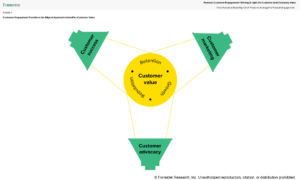How Well Are You Protecting Existing Customer Revenue?
You already know why it’s important to build and maintain good relationships with customers. Forrester data shows that existing customers, through renewal and expansion, account for 61% of B2B revenue — higher for established companies and lower for companies still in new-account growth mode. That’s a big enough slice of the pie to warrant mindshare and resources to ensure that customers attain value from your offering and, as a result, stay, grow, and advocate for your company.
You already know why. We’ve introduced expanded and upgraded versions of our customer engagement aligned approach and the foundational Forrester Customer Engagement Range Of Responsibilities Model to show you how.
Secure The Spotlight On Customer Value
The aligned approach (Forrester client access required) shows how three key functions — customer marketing, customer success, and customer advocacy — should partner in distinct yet complementary roles to optimize the postsale relationship between B2B companies and their customers. It puts customer value at the center, with each function contributing through its own lens. As with stage lighting, while a single light does a specific job, the effect grows stronger with multiple lights and coordinated angles. Companies that invest in all three areas and enable collaboration regardless of reporting lines see distinct advantages in retention, growth, and advocacy.

The Forrester Customer Engagement Range Of Responsibilities Model (client access required) guides alignment of the customer-facing functions responsible for maximizing value for customers and the company. Our extensive update reflects an evolution in competencies and responsibilities and elevates customer advocacy to sit beside customer marketing and customer success as a distinct postsale function. The model is a tool to ensure that these teams complement, rather than conflict, with each other and work seamlessly with account management, services, education, support, and customer experience.
Fix Your Gaze On Five Engagement Outcomes
The Customer Engagement Range Of Responsibilities Model is designed to align all functions in the postsale ecosystem around five key outcomes that reflect a focus on customer value:
- Value network engagement shapes the customer experience. A value network is a group of people and organizations that a customer works with to pursue the goal that drove their initial purchase. These networks play a significant role in the customers’ expectations and their use of the offering, which drives the decision to renew or repurchase and buy more.
- Product adoption ensures that users maximize the offering. Product adoption is the process by which customers begin to use an offering and integrate it into their daily workflow. It’s the path toward customer value attainment: Companies don’t see value in a solution that they aren’t using.
- Customer outcomes validate business benefits. Customer outcomes are the long-term and ongoing business benefits that customers want from deploying a product or service, including increased revenue, cost savings, and efficiency. Customers who clearly understand the value they have attained are predisposed to stay, grow, and advocate.
- Advocacy and references enhance reputation, demand, and growth. Customer advocacy takes a cohesive approach to finding and activating customer storytellers and references, elevating beyond one-off requests. Successful companies create a beneficial experience for advocates who share stories that in turn enhance reputation, encourage renewal or repurchase, and support growth.
- Account expansion increases revenue. Account expansion includes cross-sell and upsell strategies and programs that increase revenue from existing customers. Cross-selling involves selling additional products or services to a buying center not previously engaged, while upselling involves engaging an existing buying center with additional offerings.
Reach out to your account manager for access to the new model and supporting guidance, or contact us to learn more about how we approach postsale customer engagement.
